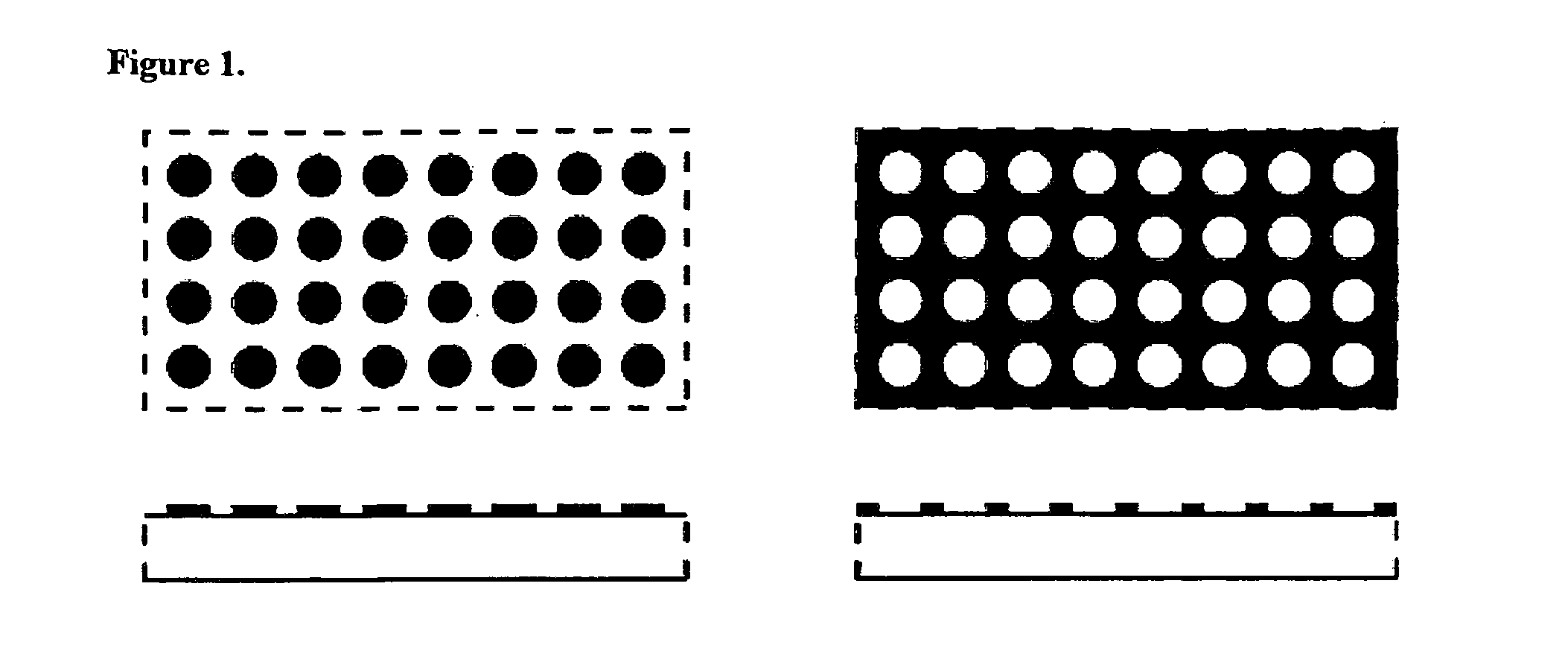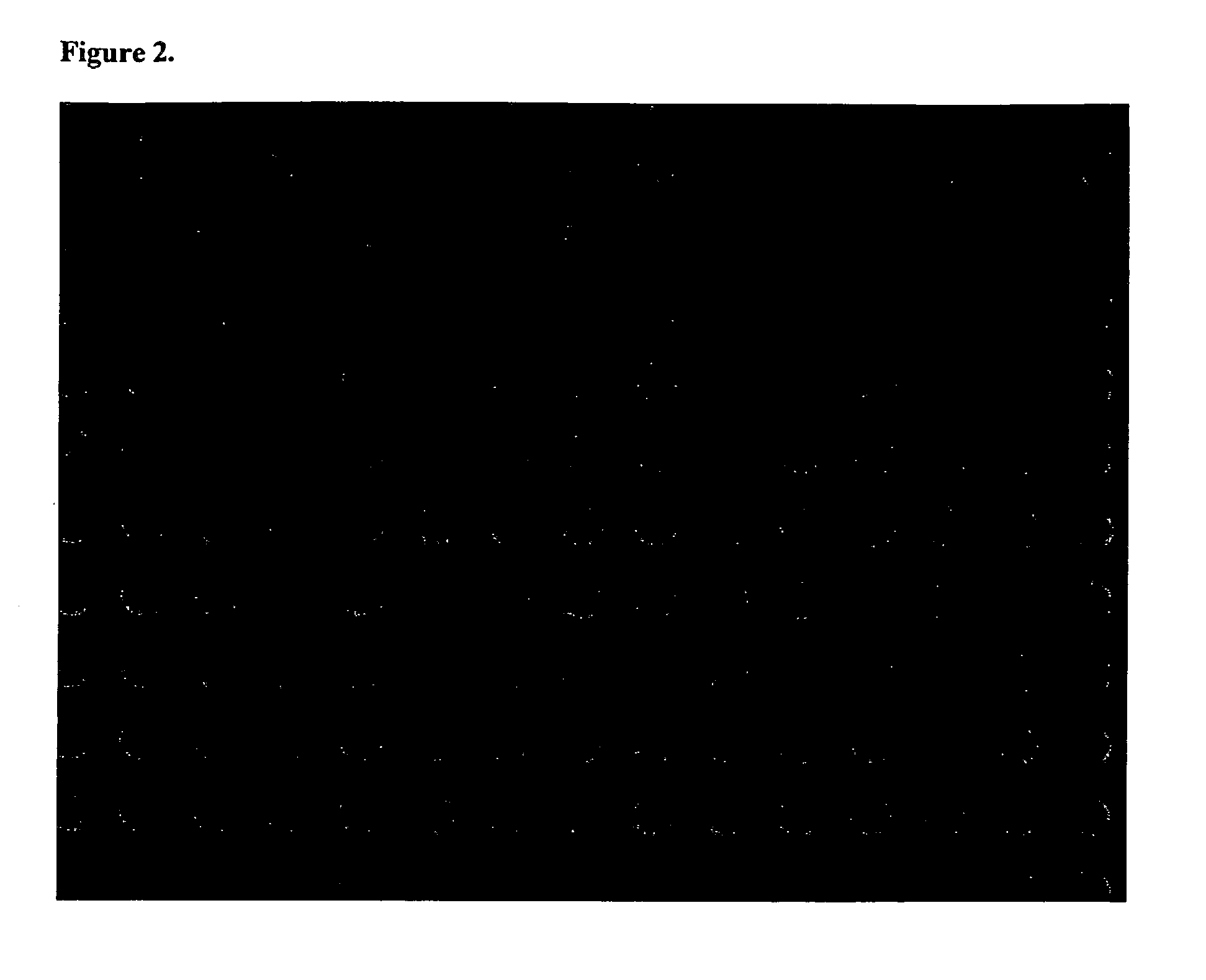Methods of making and using microarrays suitable for high-throughput detection
a microarray and detection method technology, applied in the field of making and using microarrays suitable for highthroughput detection, can solve the problems of poor detection signal-to-background signal ratio, poor addressability, and reduce the sensitivity of the assay, and achieve the effect of minimalism of nois
- Summary
- Abstract
- Description
- Claims
- Application Information
AI Technical Summary
Benefits of technology
Problems solved by technology
Method used
Image
Examples
example 1
Preparation of Microarray with Wells
[0071]A 50 nm-thick gold cladding layer is applied to the upper surface of a standard glass microscope slide by chemical vapor deposition or sputtering. Positive photoresist is spin-coated onto the cladding layer and heated to drive off any remaining solvent. Upon cooling, the photoresist is exposed to UV radiation applied through a mask bearing an array of round holes, so that the radiation incident on the surface consists of an array of round spots having a diameter of 8 μm with center-to-center spacing of 10 μm. Exposure is maintained for a suitable amount of time to cause the photoresist to be sufficiently exposed to generate the material modification. The slide is then washed to remove any soluble resist. The result is an array of holes in the resist having the same dimensions and spacing as the UV light spots and within which the gold cladding layer is exposed. The exposed gold is etched away, followed by removal of the cured photoresist, to...
example 2
Preparation of Microarray with Islands
[0072]In another preferred embodiment, the substrate is glass and the cladding layer is a metal such as Au of 50 nm thickness. The Au layer is etched, leaving behind round “islands” of 8 micron diameters and 10 micron spacings. The regions between islands are glass. Attachment of the molecular probes to the islands can occur through thiol-active methods [include protein disulphide bonds].
example 3
Immobilization of Probe Molecules within the Sensing Zones
[0073]The slides are exposed to an RF induced oxygen at 400 mTorr in a March Plasmod for 5 minutes. This chemically modifies the exposed glass in the microarray wells and leaving the gold cladding inert. After the oxygen plasma the slides are immediately placed in a vapor deposition chamber containing 0.5 ml of 3-glycidoxypropyldmethylethoxysilane (GPS). The chamber is pumped down to 3 mTorr and heated to 115° C. which allows the GPS to vaporize and attached to the modified microarray well surfaces. After 16 hours in the vapor deposition chamber the slides are removed and to be spotted with oligonucleotide probes or stored for use at a later time. Immobilization is done with the oligonucleotide probes in a phosphate buffer at 150 mM with a pH of 8.5. An aliquot of probe is placed on the desired microarray well for 30 minutes at room temperature in a humid chamber followed by 30 minutes at 75° C. in a humid chamber. After the ...
PUM
 Login to View More
Login to View More Abstract
Description
Claims
Application Information
 Login to View More
Login to View More - R&D
- Intellectual Property
- Life Sciences
- Materials
- Tech Scout
- Unparalleled Data Quality
- Higher Quality Content
- 60% Fewer Hallucinations
Browse by: Latest US Patents, China's latest patents, Technical Efficacy Thesaurus, Application Domain, Technology Topic, Popular Technical Reports.
© 2025 PatSnap. All rights reserved.Legal|Privacy policy|Modern Slavery Act Transparency Statement|Sitemap|About US| Contact US: help@patsnap.com



